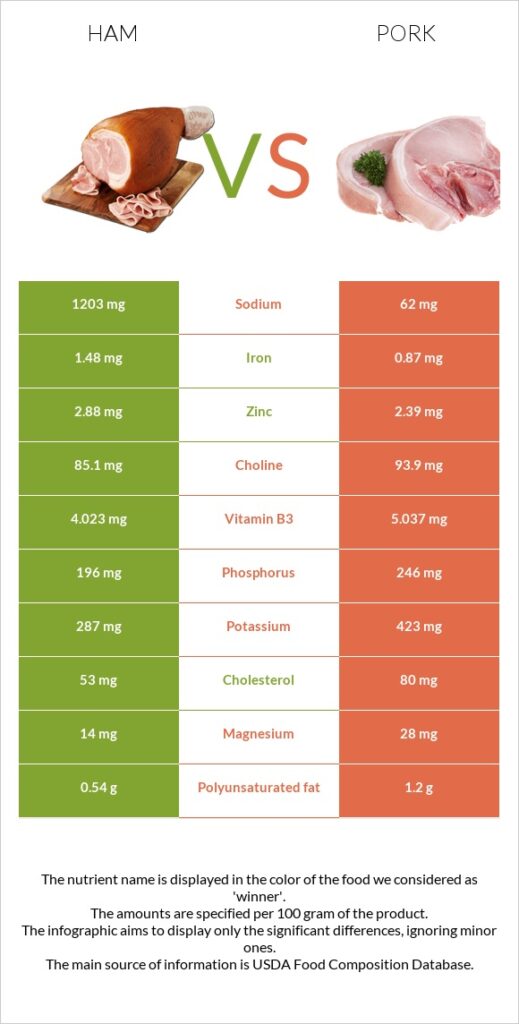
The question of whether is ham red meat or white meat often sparks debate. While many associate ham with the lighter color of poultry, its true classification lies within the realm of red meats. Understanding this distinction requires delving into the science behind meat coloration and the nutritional profiles of different types. This article aims to shed light on the nature of ham, exploring its origins, composition, and place within the broader spectrum of meat categories.
This exploration will begin by defining what constitutes ham and tracing its history as a culinary staple. We’ll then delve into the fundamental differences between red and white meats, highlighting the key factors that contribute to their distinct colors and nutritional profiles. The role of myoglobin in pork coloration will be examined in detail, explaining how this protein contributes to the characteristic reddish hue of ham. Finally, we’ll analyze the nutritional value of ham, considering its potential benefits and drawbacks within a balanced diet.
What is Ham?
Ham is a cured meat product derived from the hind leg of a pig. The curing process typically involves salting, smoking, and sometimes adding other flavorings or preservatives to enhance its taste and extend shelf life. This intricate preparation transforms the raw pork into a flavorful and versatile ingredient used in countless dishes worldwide.
Historically, ham has been a prized food source for centuries, dating back to ancient civilizations who recognized its ability to preserve meat effectively. The Romans were particularly fond of ham, incorporating it into their culinary traditions and even exporting it throughout their vast empire. Over time, various regional variations of ham emerged, each with unique curing methods and flavor profiles, reflecting the diverse cultural influences that shaped its production.
Today, ham remains a popular choice for both home cooks and professional chefs alike. Its versatility allows it to be enjoyed in sandwiches, salads, pasta dishes, breakfast platters, and even as a standalone appetizer. The rich, savory flavor of ham adds depth and complexity to countless recipes, making it a beloved ingredient across culinary landscapes.
Red Meat vs. White Meat
The classification of meat into red and white categories is primarily based on the color of its muscle tissue and the amount of myoglobin present. Myoglobin is a protein responsible for storing oxygen within muscle cells, enabling them to function efficiently during physical activity. Red meats, such as beef, pork, lamb, and venison, contain higher levels of myoglobin, which gives their flesh a characteristic reddish-brown hue.
White meats, on the other hand, include poultry (chicken, turkey, duck), fish, and some seafood. These meats have lower myoglobin content, resulting in a lighter color ranging from pale pink to white. The difference in myoglobin levels reflects the varying metabolic demands of different animal species. Red meats typically come from animals that engage in more strenuous activity, requiring greater oxygen storage capacity within their muscles.
Beyond color, red and white meats also exhibit distinct nutritional profiles. Red meats are generally richer in iron, zinc, and vitamin B12, while white meats tend to be lower in calories and fat content. However, it’s important to note that these generalizations can vary depending on the specific cut of meat and its preparation method.
Myoglobin and Pork Color
Myoglobin plays a crucial role in determining the color of pork, including ham. This iron-containing protein binds to oxygen within muscle cells, giving them their characteristic reddish hue. The amount of myoglobin present varies depending on factors such as the animal’s breed, age, diet, and level of physical activity.
Pork with higher myoglobin content appears darker red, while leaner cuts with lower myoglobin levels exhibit a lighter pink color. During the curing process for ham, salt draws out moisture from the meat, concentrating the myoglobin and further intensifying its reddish color. The smoking process also contributes to the final color by reacting with the myoglobin molecules, producing complex pigments that enhance the overall richness of the ham’s hue.
Understanding the role of myoglobin in pork coloration helps explain why is ham a red or white meat is often debated. While some may perceive ham as lighter than other red meats due to its varying shades and fat content, its inherent myoglobin concentration firmly places it within the red meat category.
Nutritional Value of Ham
Ham offers a range of nutrients that can contribute to a balanced diet when consumed in moderation. It is a good source of protein, essential for building and repairing tissues, as well as iron, which plays a vital role in oxygen transport throughout the body.
However, ham also tends to be higher in sodium and saturated fat compared to other meat options. Excessive sodium intake can contribute to high blood pressure, while high saturated fat consumption is linked to an increased risk of heart disease. Therefore, it’s important to consume ham in moderation as part of a healthy dietary pattern.
Conclusion
The question of whether is ham red meat or white meat ultimately boils down to the scientific definition of these categories based on myoglobin content. Ham, derived from pork, undeniably falls under the umbrella of red meats due to its higher myoglobin levels, which contribute to its characteristic reddish hue. While it offers nutritional benefits such as protein and iron, its sodium and saturated fat content should be considered when incorporating it into a balanced diet.
